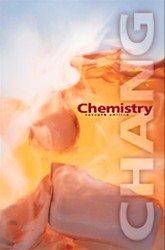|
 |  Chemistry, 7/e Raymond Chang,
Williams College
Chemical Kinetics
Internet ExercisesSpectrum database
(http://www.speclab.com/compound/chemabc.htm)
- 2,4-D is an abbreviation
for a commonly used weed killer. Use the information in the Spectrum database
at http://www.speclab.com/compound/chemabc.htm
and the find function of your browser to find information on 2,4-D.
- Examine the enviro
nmental impact information and determine what happens to 2,4-D after it
has been sprayed on the soil.
- Compare the half-life
of 2,4-D in soil with the half-life in water. What is the product of the
degradation of 2,4-D in water?
- If the half-life
of 2,4-D in a particular soil is 5 days, what percent of the 2,4-D originally
present will be present after one month?
- Use ChemFinder at
http://chemfinder.camsoft.com/
to determine the structure of 2,4-D. Does the degradation product of 2,4-D
in water make sense now that you know the structure of 2,4-D?
|
 |  |  | chemical rate kinetics
(http://edie.cprost.sfu.ca/~rhlogan/kinetics.html)
- Some chemistry instructors
at high schools and universities create educational homepages for students,
not necessarily their own. R.H. Logan of North Lake College has a site dedicated
to reinforcing various general chemistry topics. Check out what he has on
chemical rate kinetics at http://edie.cprost.sfu.ca/~rhlogan/kinetics.html.
- How does temperature
affect the rate of a reaction?
- Look at the diagram
given in the catalysis section. How does a catalyst affect a reaction?
- True or False: The
change in free energy of an uncatalyzed reaction is greater than that
of a catalyzed one.
- What does concentration
have to do with the collisional theory of reaction rates?
- If the overall order
of a reaction is 2, does this mean that the reaction is bimolecular?
|
 |  |  | University of Akron
(http://ull.chemistry.uakron.edu/genobc/)
- The University of Akron
provides help in three subdisciplines of chemistry: general, organic, and
biochemistry. Go to http://ull.chemistry.uakron.edu/genobc/,
and click on the course animations list. Then download number 48, heterogeneous
catalysis.
- What does binding
to the surface of the catalyst do to the gaseous molecules?
- How does heterogeneous
catalysis differ from a homogeneous one?
|
|
|



 2002 McGraw-Hill Higher Education
2002 McGraw-Hill Higher Education

 2002 McGraw-Hill Higher Education
2002 McGraw-Hill Higher Education